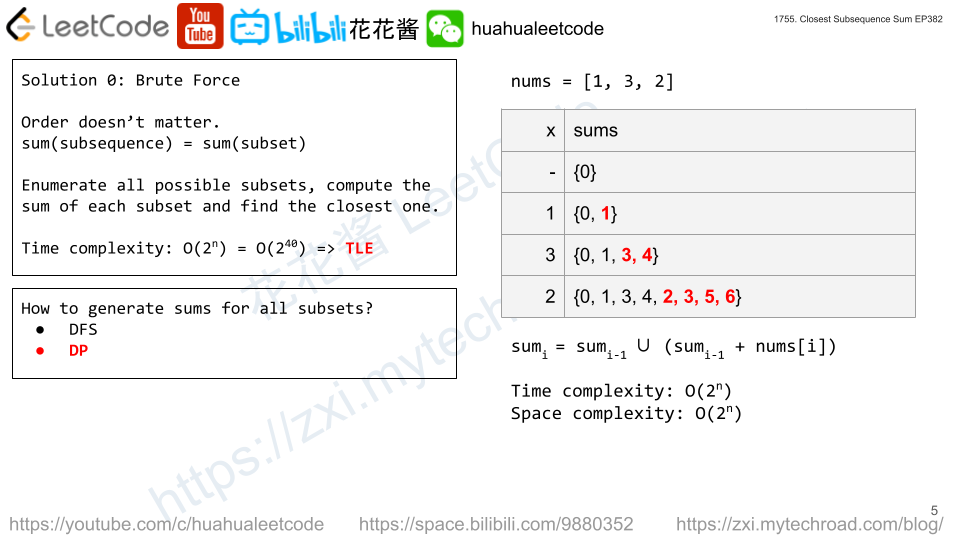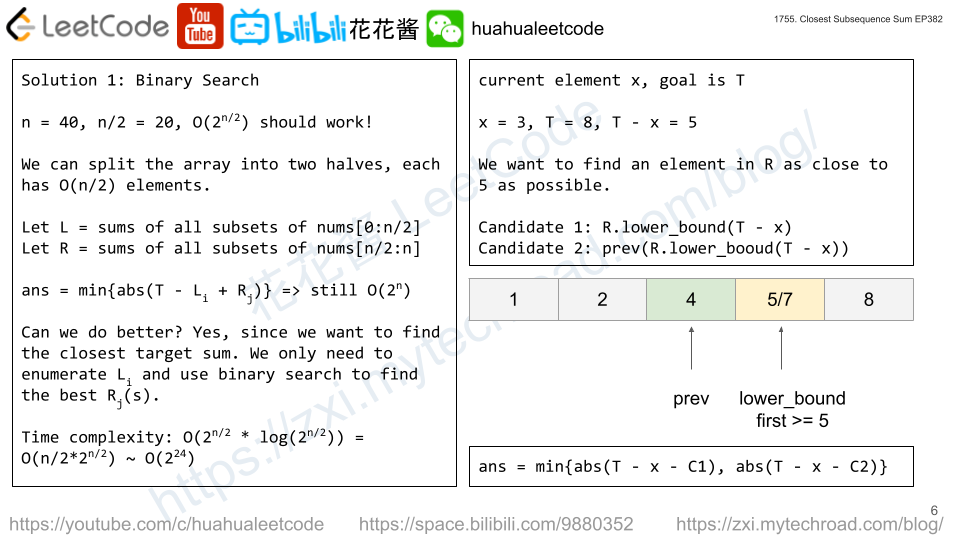You are given an integer array nums and an integer goal.
You want to choose a subsequence of nums such that the sum of its elements is the closest possible to goal. That is, if the sum of the subsequence’s elements is sum, then you want to minimize the absolute difference abs(sum - goal).
Return the minimum possible value of abs(sum - goal).
Note that a subsequence of an array is an array formed by removing some elements (possibly all or none) of the original array.
Example 1:
Input: nums = [5,-7,3,5], goal = 6 Output: 0 Explanation: Choose the whole array as a subsequence, with a sum of 6. This is equal to the goal, so the absolute difference is 0.
Example 2:
Input: nums = [7,-9,15,-2], goal = -5 Output: 1 Explanation: Choose the subsequence [7,-9,-2], with a sum of -4. The absolute difference is abs(-4 - (-5)) = abs(1) = 1, which is the minimum.
Example 3:
Input: nums = [1,2,3], goal = -7 Output: 7
Constraints:
1 <= nums.length <= 40-107 <= nums[i] <= 107-109 <= goal <= 109
Solution: Binary Search


Since n is too large to generate sums for all subsets O(2^n), we have to split the array into half, generate two sum sets. O(2^(n/2)).
Then the problem can be reduced to find the closet sum by picking one number (sum) each from two different arrays which can be solved in O(mlogm), where m = 2^(n/2).
So final time complexity is O(n * 2^(n/2))
Space complexity: O(2^(n/2))
C++
|
1 2 3 4 5 6 7 8 9 10 11 12 13 14 15 16 17 18 19 20 21 22 23 24 25 26 |
// Author: Huahua class Solution { public: int minAbsDifference(vector<int>& nums, int goal) { const int n = nums.size(); int ans = abs(goal); vector<int> t1{0}, t2{0}; t1.reserve(1 << (n / 2 + 1)); t2.reserve(1 << (n / 2 + 1)); for (int i = 0; i < n / 2; ++i) for (int j = t1.size() - 1; j >= 0; --j) t1.push_back(t1[j] + nums[i]); for (int i = n / 2; i < n; ++i) for (int j = t2.size() - 1; j >= 0; --j) t2.push_back(t2[j] + nums[i]); set<int> s2(begin(t2), end(t2)); for (int x : unordered_set<int>(begin(t1), end(t1))) { auto it = s2.lower_bound(goal - x); if (it != s2.end()) ans = min(ans, abs(goal - x - *it)); if (it != s2.begin()) ans = min(ans, abs(goal - x - *prev(it))); } return ans; } }; |
请尊重作者的劳动成果,转载请注明出处!花花保留对文章/视频的所有权利。
如果您喜欢这篇文章/视频,欢迎您捐赠花花。
If you like my articles / videos, donations are welcome.



Be First to Comment